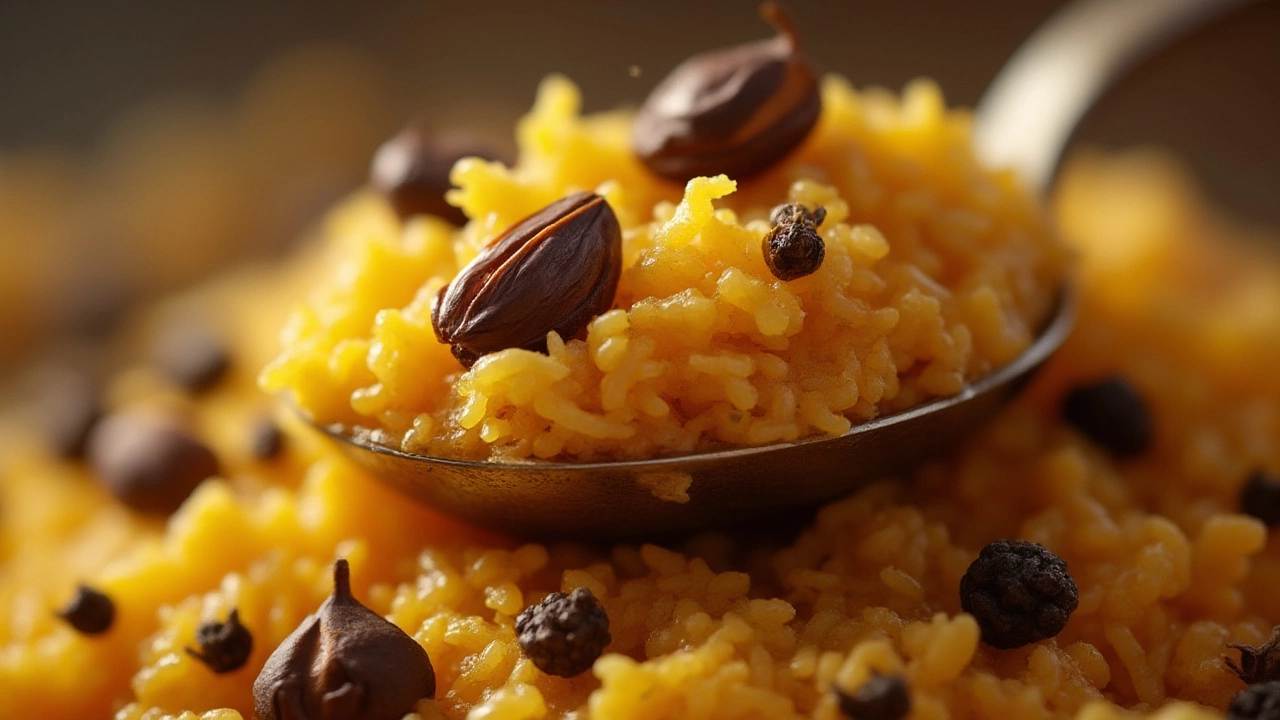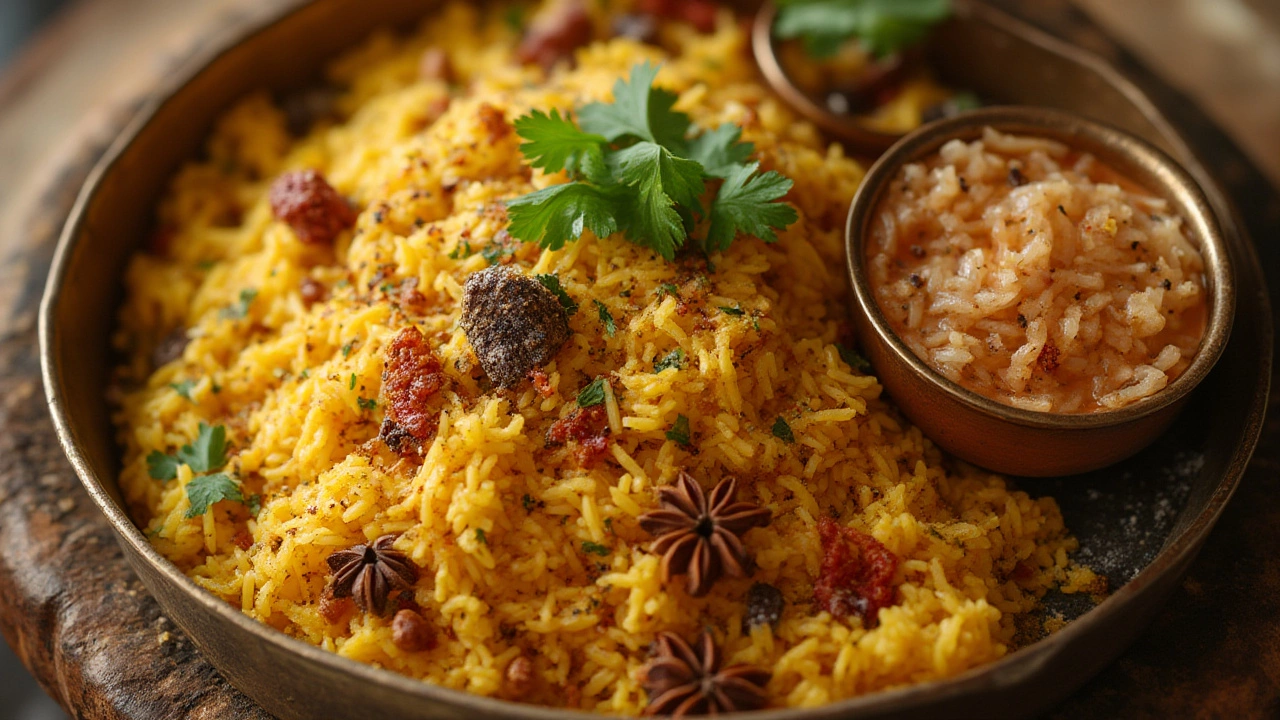Next time you dig into a steaming bowl of biryani and your fork hits a mysterious little black pebble, do you pause and wonder, "What on earth is this?" You're not alone. Over my years of cooking biryani at home—usually with my daughter Nisha eagerly waiting and my cat Luna sniffing the air—I’ve fielded this question countless times. That tiny black thing stirs up a surprising amount of curiosity, sometimes confusion, and for the unprepared, even a yelp! Let’s break open the mystery in the most aromatic way possible.
Spotting the Small Black Thing: What Are You Actually Seeing?
Biryani is all about extravagant flavors, vibrant colors, and, yes, a riot of whole spices. Among the cardamom pods, bay leaves, and cloves, the most common little black traveler hiding in your rice is the black cardamom pod. If you look closer, though, you’ll notice there could be more than one contender for that "small black thing" title: black peppercorns, black cumin seeds (shahi jeera), cloves, and even stray star anise petals. These are not random extras, but essential flavor boosters.
Take black cardamom for example. It's bulkier and darker than green cardamom, and it's what punches that warm, smoky aroma into each mouthful. Sometimes you spot a rounder, tiny black ball—that’s likely a peppercorn. Crunchy and slightly spicy, but a surprise if you bite hard! If it's elongated, it's probably a clove; and the thin, almost crescent-shaped one could be a piece of star anise. The thing is, each of these spices is chosen with care. No shortcuts for that classic taste.
Here’s a quick breakdown so you can become a biryani sleuth at home:
| Spice Name | Shape | Color | Role in Biryani |
|---|---|---|---|
| Black Cardamom | Large, ribbed pod | Dark brown-black | Smoky taste |
| Black Peppercorns | Small, round | Solid black | Sharp heat boost |
| Cloves | Small, nail-like | Deep brown-black | Sweet, earthy aroma |
| Shahi Jeera (Black Cumin) | Tiny, curved | Jet black | Earthy, nutty hint |
| Star Anise | Star-shaped segment | Black-brown | Warm, licorice note |
It’s almost like a flavor treasure hunt in your bowl. And to be honest, most of us don’t really eat these whole—unless it’s by accident. They’re in there for what they give, not for you to chew on! I always warn Nisha before dinner: watch out for surprise crunchies!
Why Do Chefs Add Whole Black Spices To Biryani?
At first glance, it might seem annoying—dodging "pebbles" while eating rice. But here’s why chefs insist on dropping in whole spices, not just powder: The slow cooking and steaming allow these spices to release essential oils without dominating every bite. You need the entire pod or seed sitting in there like a silent actor, working its magic from the sidelines.
Powdered spices—think garam masala—give you a quicker burst, but they’re not the same as the complex, layered perfume of a biryani cooked with whole spices. Black cardamom, for instance, withstands the long simmering, holding on to its personality. The same goes for peppercorns and cloves. Think of it as building a slow-release flavor bomb.
Cultural tradition also plays a huge part. Every Indian household seems to swear by their own mix, passed down generations. My grandma always said, “You can’t have biryani without the real black cardamom! It’s not just for taste, it’s for that smell that makes everyone drool before dinner.”
Here's another fun fact: In restaurant kitchens, chefs sometimes fish out the visible spices before serving to avoid surprises. But in home kitchens, we usually leave them in for you to sniff, spot, and respectfully push aside. If you’ve ever wondered why your home biryani smells so much better the next morning, thank those intact spices—they’re still working while your rice is resting!

Should You Eat the Black Things in Biryani? Answers for the Brave and the Cautious
This might sound silly, but the number of times I've seen someone chomp down on a spice pod and instantly regret it—well, it's half the fun of a family biryani feast. So, should you eat the black things? In short, not if you want to enjoy your meal with teeth intact and taste buds happy.
Black cardamom pods are fibrous, tough, and really too intense to chew directly. Biting a peppercorn can flood your mouth with a heat spike—and for some folks, it’s almost tear-inducing. Nisha once dared a peppercorn, and let’s just say she drank more lassi than usual that day. Cloves and star anise fragments pack too much flavor in one bite to be enjoyable alone.
If you accidentally bite one, no harm done (besides a potent wake-up call). Spit it out neatly and tuck it to the side of your plate. Don’t feel awkward; even chefs do the same. Only black cumin is sometimes used whole, but even that can be strong for some tastes.
So, next time you see a small black thing nestled in your rice, just see it as a sign you’re eating the real deal. Pro tip: Point it out to your kids or friends and watch them become instant food detectives. Even Luna, my usually aloof cat, has developed an eye for the difference between raisins and black cardamom pods after too many kitchen sniffs.
If you’re making biryani at home, feel free to use a spice infuser—like a tea strainer—for whole spices. Just toss it in with your rice, then remove before serving. You get all of the flavor, none of the surprises!
Interesting Spice Facts and Tips to Master Biryani Like a Pro
Every time you cook with whole spices, you join a centuries-old tradition. Black cardamom is dried by smoking, giving it that unique aroma—nothing else in the spice rack smells like it. Unlike most spices, it’s used for its flavor, not its looks. Black cumin is actually different from the regular cumin; it’s nuttier, subtler, and costlier. If you ever visit a spice market, just sniff a black cardamom and a green one side by side—the difference is wild!
Here are a few hands-on tips for your next biryani adventure:
- If serving biryani to kids or spice-averse eaters, pick out the obvious pods right before serving. Nobody enjoys a toothy scare mid-dinner.
- Want to amp up the aroma? Crush your black cardamom slightly before tossing it in. Don’t go crazy—just a little bruise with the back of a spoon releases more flavor.
- Keep your whole spices in airtight containers. Light and humidity dull the magic over time. A study in 2023 showed that storing spices in dark cupboards preserves volatile oils longer (meaning more flavor for your rice).
- If you’ve run out of black cardamom, try adding a little smoked paprika for a hint of warmth, but nothing truly replaces the real thing.
- If you can’t find shahi jeera, you can use regular cumin, though you’ll miss out on a subtle layer of earthiness.
- Whole spices aren’t just for biryani—add extra to your next stew, soup, or even tea for unexpected depth!
And for those who appreciate a good food stat: India grows over 70% of the world’s black cardamom, and about 30% of it gets used right in festive biryanis every year. That’s millions of little black pods spicing up family meals!
So the next time you spot that small black thing in your biryani, you know it’s not a mistake, but a carefully chosen flavor hero. Respect it, maybe dodge it if your teeth protest, but never forget the magic it leaves behind in every fragrant bite.
